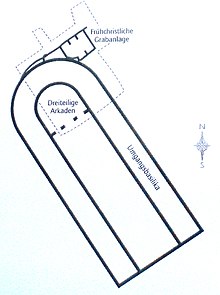Communal basilica on Via Ardeatina
In 1991, another basilica was found and excavated in Rome between Via Ardeatina and Via Appia . This anonymous Christian sacred building is referred to in the specialist literature as the communal basilica on Via Ardeatina .
Location and patronage
The one near the Catacomb of Calixtus and about 600 m from the location 'Domine, quo vadis?' The basilica on the Via Appia was discovered by chance because in the sparse vegetation of a field above the Via Ardeatina the walls of Exedra and the gallery as part of the underlying wall complex of a basilica were clearly visible. The 'Pontificia Commissione di Archeologia Sacra' was then able to uncover the floor plan of the basilica as well as numerous graves with grave goods and examine them archaeologically .
According to the latest research results, the emergence should be set at 336. If this dating is correct, it could be the funeral basilica mentioned in the Liber Pontificalis , which is said to have been built on imperial property by Pope Mark (336) with financial support from Emperor Constantine the Great . The characteristics of the other five Roman basilicas also apply to the new discovery: It is located outside the Aurelian city wall and in the immediate vicinity of the 'Anonymous Catacomb of Via Ardeatina' with a martyr memorial; it was created in the 4th century through imperial support, had the function of a coemeterial basilica from the beginning and did not serve as a parish church.
The names of the martyrs to whom the basilica was originally consecrated could not yet be determined; The connection with the catacomb just a few meters to the east is also unknown. Although the single grave in the center of the basilica, which is particularly prominent, is regarded as the tomb intended by Pope Mark for himself, it is not known whether and when the funeral basilica received a St. Mark's patronage .
Building history
The basilica on Via Ardeatina is built in the same structural form and with approx. 66 × 28 m also has dimensions comparable to the three older basilicas, namely the basilica of Santi Marcellino e Pietro on Via Labicana , the basilica at Tor de'Schiavi the Via Praenestina and the Basilica Apostolorum ( San Sebastiano fuori le mura ) on the Via Appia . Only the two most recent burial basilicas, the Basilica of Sant'Agnese ( Sant'Agnese fuori le mura ) on Via Nomentana and the Basilica maior ( Saint Lawrence in front of the walls ) on Via Tiburtina , are considerably longer and wider.
The basilica on Via Ardeatina was a three-aisled pillar basilica , the side aisles of which ran semicircularly around the central nave; Pillars with arcades separated the nave from the aisles. There was a spatial separation between the presbytery and the nave with three arcades. The floor of the basilica was covered with tombs; Here, too, it was a question of 'shaft graves', which were bordered by walls and covered in the length of a gable-shaped with brick plates placed against each other, sometimes also in several levels one above the other. The floor covering above often consisted of marble slabs.
A tomb in the middle of the presbytery, privileged by its location and size, must have been planned when it was built. Therefore the burial place intended for Pope Marcus as donor is assumed here; This is also supported by the later name of the basilica as San Marco sull'Ardeatina. According to the inscriptions found, the burials took place in the period from 368 to 445.
To the northeast of the apse was a small square mausoleum with a portico . After the bones of the founder pope were transferred in the 12th century to the inner-city basilica of San Marco (Rome) , which he also founded, the burial church began to fall apart through stone robbery.
literature
- Vincenzo Fiocchi Nicolai: Early Christianity in "Domine Quo Vadis". The newly found early Christian basilica on the Via Ardeatina in Rome . In: Antike Welt 29 (1998), p. 305ff. with many pictures.
- Hugo Brandenburg: The early Christian churches in Rome from the 4th to the 7th century , Regensburg 2013, p. 93.
- Steffen Diefenbach: Roman memory rooms. Memory of saints and collective identities in Rome from the 3rd to 5th centuries AD , Berlin 2007, pp. 101ff.
- Ursula Leipziger: The Roman basilicas with handling. Research historical inventory, historical classification and primary function , Erlangen 2006, p. 47ff.
- Hans Georg Wehrens: Rome - The Christian sacred buildings from the 4th to the 9th century - Ein Vademecum , Freiburg, 2nd edition 2017, p. 86f.
Individual evidence
- ↑ Vincenzo Fiocchi Nicolai: Early Christianity in "Domine Quo Vadis". The newly found early Christian basilica on the Via Ardeatina in Rome . In: Antike Welt 29 (1998), p. 305ff.
- ^ Hugo Brandenburg: The early Christian churches in Rome from the 4th to the 7th century , Regensburg 2013, p. 93
- ↑ Hans Georg Wehrens: Rome - The Christian sacred buildings from the 4th to the 9th century - Ein Vademecum , Freiburg, 2nd edition 2017, p. 86f.
- ↑ Ursula Leipziger: The Roman basilicas with handling. Research historical inventory, historical classification and primary function , Erlangen 2006, p. 47ff.

